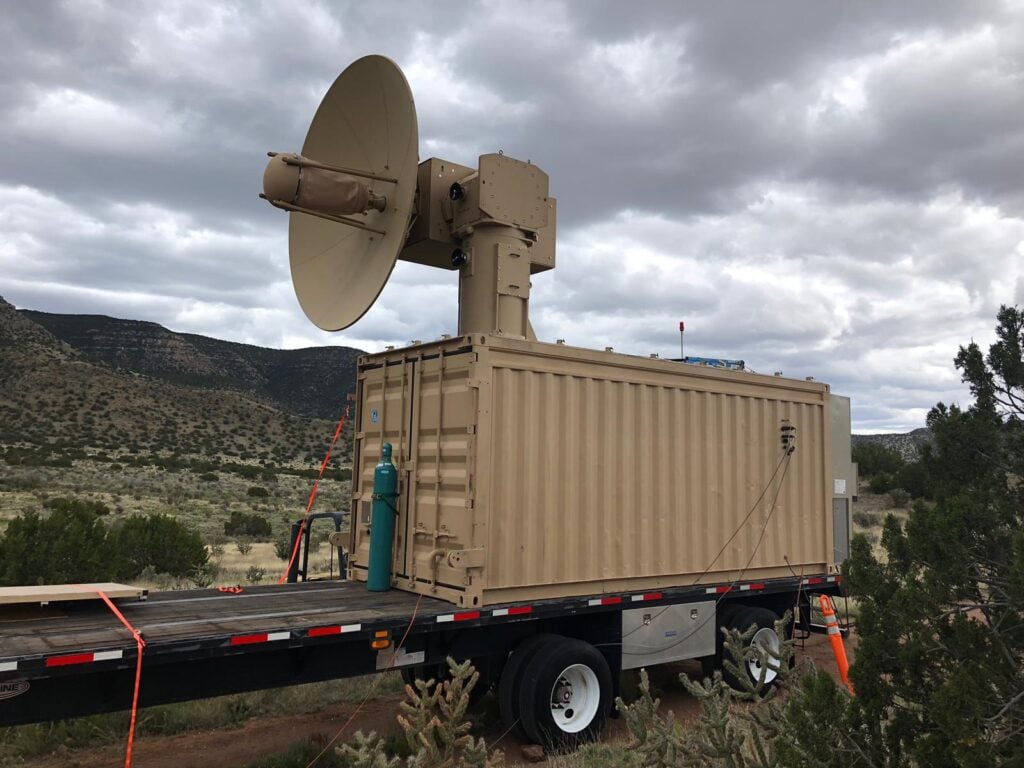
The Air Force’s THOR high-powered microwave weapon is designed to burn out swarms of attacking drones.
WASHINGTON: The Air Force is testing its prototype drone-killing microwave, the Tactical High Power Microwave Operational Responder (THOR), “in a real-world setting” in Africa, says Richard Joseph, the Air Force’s chief scientist. Given how Iran and its proxies have used drone swarms, this would seem to be a good place to test without risking escalation, or Iran developing countermeasures.
“We have recently deployed a test system to Africa for base defense … based on a microwave system. And the purpose is to be able to disrupt and destroy the performance of drones or swarms of drones,” he told the Mitchell Institute today. “It’s been tested extensively, works remarkably well. … I’ve watched it in action and it’s really quite impressive.”
He demurred on providing details about when THOR might be ready for operational deployment, but did note that technology development is ongoing and that in the end the service may choose a different weapon system. That said, Joseph said THOR was “better than anything else” the service has right now, and noted that “the capabilities that can be incorporated in system are increasing day by day.”
As only Breaking D readers know, the Air Force back in August was readying THOR for overseas field experiments, with Army warfighters in particular keen to get their hands on directed-energy weapons designed to counter small unmanned aerial systems (C-sUAS). THOR uses high-powered microwaves to fry drones’ electronics, shooting swarms out of the sky at short ranges. If anti-drone lasers are like sniper rifles, microwave weapons are like shotguns full of birdshot.
THOR was designed by the Air Force Research Laboratory (AFRL), and it uses a radar that AFRL bought from Idaho-based startup Black Sage last month.
Enabling “logistics under attack,” including figuring out how to protect bases, is one of the Air Force’s top-four priorities for the future. The Air Force’s Strategic Development Planning & Experimentation (SDPE) Office, which leads service field experiments including the THOR testing, announced in April that it also was going to deploy Raytheon’s High Energy Laser (HELWS) and High Power Microwave (PHASER) prototypes for overseas testing. Finally, AFRL also is working on the Counter-Electronic High-Power Microwave Extended-Range Air Base Air Defense (CHIMERA), designed to defeat targets at medium to long ranges.
While the Army is also interested in microwave weapons for base defense, its leadership has decided to let the Air Force take the lead in developing microwave weapons that might be used by both services, and is focus its own research and development funding on using lasers to kill drones. Meanwhile, as Sydney reported on Monday, the Army has put together a new Army Installations Strategy that lays out a vision for making Army bases in the US more resilient, adaptable and connected. While that strategy emphasizes cyber threats and disinformation, it also includes physical security — and small, cheap drones are a growing threat.
An interagency tug-of-war is brewing between the Air Force and the Army (as well as the Navy) on responsibility for defending air bases both abroad and at home. Air Force leaders are arguing that the costs of protecting those bases is not just its burden to bear; rather that its sister services have to pay up as well.
Air Force Chief of Staff Gen. Charles Brown told the Senate Armed Services Committee in written answers for his confirmation hearing that the time has come for a new roles and missions study, in part to sort out who is responsible for base protection. “With the growing threat and joint operations from more distributed locations, the roles and missions for base defense—from the fence line to all the way up to hypersonics—is worthy of discussion and review,” he said.
A May report by RAND Corporation’s Project Air Force also raised an alarm on growing base threats. “The gap between the cruise missile threat and the U.S. joint force’s capacity and capability to counter the threat is particularly worrisome. Constraints on resources and Army prioritization of mobile short-range air defenses for forward forces suggest that shortfalls in air base air defenses are likely to continue unless U.S. Department of Defense force planning and posture decisions give higher priority to these point defenses.”
The RAND report concluded:
- Air base defense has been an enduring area of disagreement and frustration for the Army and Air Force.
- The misalignment of service responsibilities and priorities for air base defense hinders the correction of enduring shortfalls.
- The limitations of joint force development processes, Army resource constraints, and Air Force ambivalence have contributed to the base defense roadblock.
- The Air Force may be able to bypass this roadblock through innovation and the use of advanced technologies, such as directed energy.
- The most robust strategy to improve air base defenses would pursue parallel lines of effort.
Airbus, UK agree $152 million deal for 6 H145 ‘overseas’ helicopters
The fleet of light-twin rotorcraft will replace Airbus Puma HC2 types, which have been temporarily based in Brunei for British Army training and the island of Cyprus in support of Royal Air Force search and rescue missions.


























